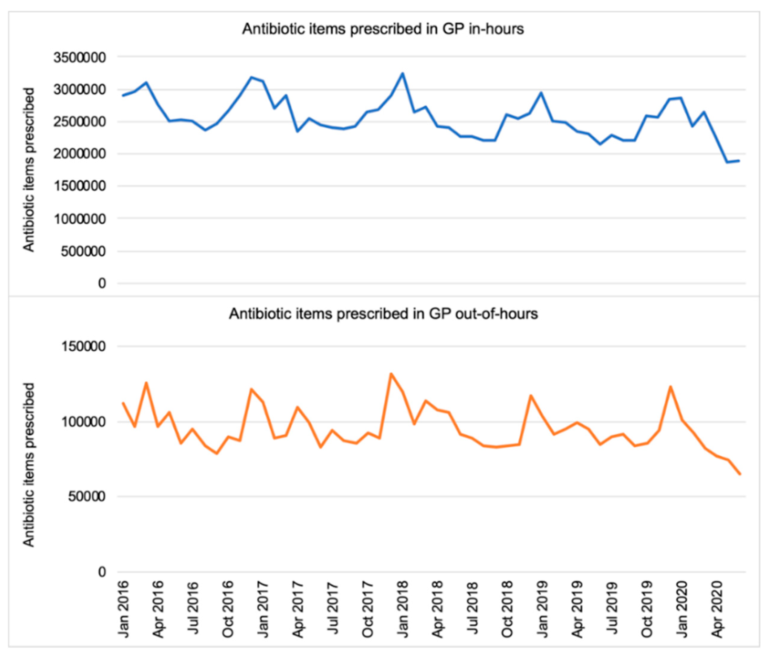Overuse of antibiotic prescriptions for patients with upper respiratory illnesses at urgent care clinics in the United States has been an ongoing challenge, but a new study led by researchers at two Utah health systems—Intermountain Health and University of Utah Health—finds that a targeted approach utilizing antibiotic stewardship practices significantly reduces overuse of these medications.
In this study, published today in JAMA Network Open, researchers were able to reduce prescribing rates at urgent care clinics by 15%—which equates to millions of doses of antibiotics—by using antibiotic stewardship initiatives specifically designed for these outpatient settings.
They say that when health care systems create and implement a tailored and targeted intervention designed specifically for urgent care facilities, they can be successful in ensuring patients are receiving more appropriate care for their illnesses.
Edward Stenehjem, MD, MSc, from Intermountain Health, and Adam Hersh, MD, Ph.D., from University of Utah Health, both in Salt Lake City, led the study involving 38 Intermountain urgent care centers throughout Utah.
“Antibiotic stewardship can be done—and done well in urgent care settings,” said Dr. Stenehjem, principal investigator of the study for Intermountain Health. “That’s especially true for urgent care centers that are integrated into health care systems. These results show the role we can play in reducing prescribing rates in these critical and unique care settings, which is better for patients and our community overall.”
Urgent care facilities play a critical role in American health care. They’re one of the fastest growing sites of outpatient delivery care in the U.S., with patient visits increasing by 50% or more in recent years.
As beneficial as they are in meeting important, but not emergency medical situations, urgent cares have also lagged in terms of antibiotic stewardship. Clinicians in these settings are more likely to prescribe antibiotics even when they are not likely to help a patient, which can lead to dangerous side effects and contribute to antibiotic resistance.
For the study, researchers from Intermountain created an urgent care-specific antimicrobial stewardship program for 38 different urgent care facilities in Utah, including 32 for patients of all ages—and six for children younger than 18 years old.
The intervention initiative included physician and patient education, new electronic health record tools, transparent clinic benchmarking dashboards, and media targeted to patients and clinicians to enhance education and awareness.
Researchers tracked antibiotic prescriptions given out for respiratory conditions, including for bronchitis, sinusitis and pharyngitis. They chose respiratory illnesses because they’re the most common reason patients go to urgent care, and also due to the high rates of inappropriate antibiotic prescriptions given for them, said Dr. Stenehjem.
Researchers then compared prescribing rates before and after the intervention and found a steep decrease.
From July 1, 2018, to June 30, 2019, before the intervention, antibiotics were prescribed for 48% of respiratory patient encounters at these urgent care settings. During the intervention period—from July 1, 2019, to June 30, 2020—that rate dropped to 33%.
“The study provides an excellent model for what can be done to improve antibiotic prescribing in urgent care. We encourage other healthcare systems and healthcare professionals to consider implementing these approaches in their urgent care practices. It will go a long way toward optimizing patient safety and combating antibiotic resistance,” said Dr. Lauri Hicks, director of the CDC’s Office of Antibiotic Stewardship.
These lower rates have been maintained after the study period, and continue to be under 30%, showing that that targeted intervention continues to work in these settings.
Dr. Stenehjem said that these results show that, when taking into consideration urgent care clinicians and patient needs—and addressing those specific needs in these busy, high-volume outpatient settings—antibiotic prescribing rates can be safely reduced.
“These results emphasize the importance of health systems including urgent care clinics as part of antibiotic stewardship solutions,” said Dr. Stenehjem. “This isn’t one clinic. This isn’t two clinics. This is 38 clinics. When you think about the impact that this has on one community, this is a huge difference. It’s millions of doses of unnecessary antibiotics avoided.”
More information:
Implementation of an Antibiotic Stewardship Initiative in a Large Urgent Care Network, JAMA Network Open (2023).
Provided by
Intermountain Healthcare
Citation:
Study finds stewardship program significantly reduced prescribing rates of antibiotics at urgent care centers (2023, May 11)



